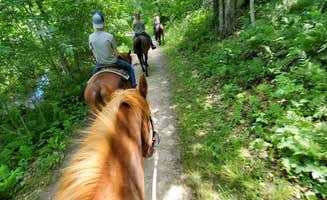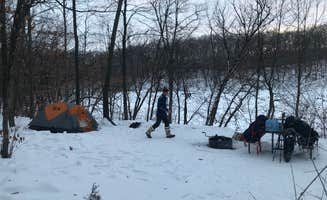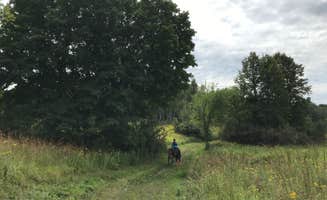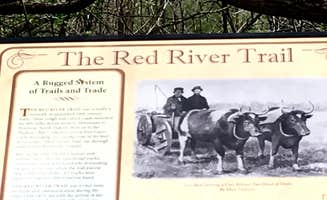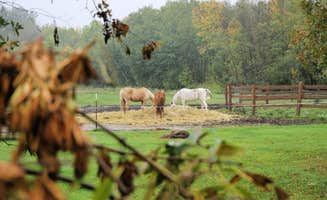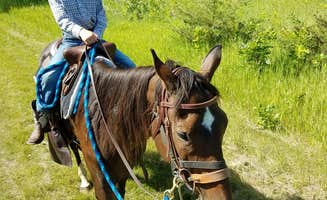Equestrian camping near Waite Park, Minnesota offers riders access to diverse trail systems through mixed woodland and prairie terrain. The area sits at the intersection of three ecological zones—hardwood forest, tallgrass prairie, and the Mississippi River valley—creating varied camping and riding experiences across seasons. Trail conditions vary by location, with some campgrounds restricting horse access during spring thaw when ground is soft.
What to do
Horseback riding on single-track trails: At Crow Hassan Park Reserve, equestrians can explore sandy prairie trails that provide relief from insects. "This is my all-time favorite park to bring my horse to, and it's her favorite trail too. Seriously, when we head back to our trailer she will stop and refuse to proceed," notes Krista T. The park includes two horse camping locations with overhead hitching lines available.
Lake swimming after rides: Many riders cool off at Lake Maria State Park Campground after trail rides. The park features wooded trails with multiple water access points. "Only about a mile from the parking lot. This site was nearly surrounded by a lake which lended to a lot of bugs, but was absolutely gorgeous," reports Lydia N. Horse riders often select sites near water sources for both rider and equine comfort.
Winter trail riding: Several campgrounds maintain select trails for winter equestrian access. Equestrians can ride throughout the year with proper planning. The routes are typically marked and maintained even during winter months. "We went in the middle of Summer. High bug season. Take a look at other reviews as they come in and see what time of year they visited," suggests Steph H., highlighting the importance of seasonal planning for equestrian activities.
What campers like
Private riding access: At Ann Lake, riders appreciate the secluded sites away from general campers. "Sites are large with varying degrees of privacy. Well spaced out, just some have less undergrowth," reports Kari P. Equestrian sites typically provide more space for trailers and horse containment than standard camping areas.
Waterfront riding options: The combination of lake access and riding trails draws equestrians to Mille Lacs Kathio Petaga Campground. "Located just south of Mille Lacs in central Minnesota, Mille Lacs Kathio State Park is large and welcoming," notes Brian C. The park offers riders multi-use trails that connect riding areas with camping zones and water access.
Group camping facilities: Equestrian groups can reserve shared camping areas at several parks. "The barn stalls are available for use (unlike the Blue Stem horse site), otherwise there are overhead horse hitch lines," explains Krista T. about Crow Hassan Park Reserve. These group sites allow multiple horse trailers to park together, creating convenient basecamp operations for trail riding groups.
What you should know
Bug preparation essential: Mosquitoes and biting flies can be intense during summer months. "When we pulled up to the parking lot we knew we were in trouble. The black flies were dive bombing the car like a scene from Armageddon," warns Steph H. Equestrian campers should bring insect protection for both humans and horses, particularly during peak summer months.
Seasonal restrictions: Some trail systems close during spring thaw to prevent damage. "I visit here often, great walking trails and wildlife," mentions Kelli D. about Lake Maria State Park, highlighting the need to check trail conditions before planning rides. Water crossings may be affected by seasonal flooding or low water levels.
Varied terrain challenges: Trail difficulty ranges from beginner-friendly to technical riding depending on location. "The hike itself is rather hilly, and the site is about a quarter mile off of the main path," describes Brian C. Equestrian campers should prepare for diverse terrain including sandy areas, wooded sections, and occasional water crossings.
Tips for camping with families
Kid-friendly riding programs: Baker Campground offers organized activities for young riders. "We spent a weekend close to home, but feel like you are getting away," notes Jennifer H. Family-oriented equestrian sites typically offer lead-line experiences and controlled riding environments for beginners.
Trail difficulty ratings: Check trail maps for difficulty ratings before planning family rides. "This has an amazing beach. Great Trails. Sweet single track for mountain biking. The best kids park at any campground I've been to," states Daniel R. about Lake Rebecca Park Reserve. Beginner riders should start with flat, wide trails before advancing to more challenging terrain.
Non-riding activities: Plan alternative activities for family members who don't ride. "The campground was quiet and clean. My husband was with me and he and buddies went hunting for game birds," mentions Amy G. Many equestrian campgrounds offer fishing, swimming, and hiking options for non-riders in the family.
Tips from RVers
Horse trailer parking: Country Camping Tent & RV Park accommodates large horse trailers with living quarters. "HUGE sites! You can either relax in the pool or even take a ride down the rum river in a rented canoe, tube, or kayak," reports Spencer C. The campground includes pull-through spots designed for large rigs with extra parking for horse trailers.
Electric hookups for equestrian sites: When camping with horses in cooler weather, electric sites help maintain trailer comfort. "This campground is great for everyone! It has 30amp and 50amp hook ups and has pull through spots," explains Spencer C. Electric sites often fill quickly during popular riding weekends, requiring advance reservations.
Accessibility considerations: Some equestrian camping areas have limited access for larger rigs. "The road into this group site only is wide enough for one vehicle at a time, so far I've been lucky to not encounter another vehicle as I'm entering or leaving," cautions Krista T. RVers should research road conditions and turning radius limitations before arriving with large horse trailers.


